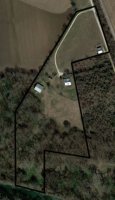DustyBoot
Loving the herd life
Hi y'all,
Here's for my first big question: fences and layout. We're on just under 14 acres in central Texas, north of Austin. Right now my thinking is a couple of Dexter cows (renting a bull from a friend annually) and maybe 5-10 goats (Boer/Spanish seems to be the popular type around here, but I'd like one or two dairy does for fun). I'm including a satellite view of the property for reference. As you can see, there's both pasture and woods. The woods have a lot of underbrush and would probably be goat heaven. A mixture of cows and goats seems like it would make for efficient use of the available resources. We have prior experience with cows, and we've always wanted goats but never had the fences for them. The front (north) section of the property is currently in hay, and I'm thinking we might keep it that way. There's also talk about putting in a metal building with an RV pad, commercial kitchen, office, and aquaponics up there. Over on the northwest-ish side of the property is probably where we'll be putting bees, rabbits, chickens, and a vegetable garden.
So, that leaves the south section of the property, behind the house. Call it about 8 acres. Would it work to fence off, say, 4 long paddocks (north-south), and rotate among them? Or would that be too small? There are a few reasons for that layout:
1) The south side of the property will flood to varying degrees, so we'd like to keep all infrastructure as far north as reasonably possible. We'd build one shed/barn structure with a fence setup that allows us to open/close access to the different pastures as desired.
2) There's access to water along that fence behind the house.
3) That allows each paddock to have a mixture of woods and grass.
We'd put a buck pen somewhere... maybe over by the pole barn.
I'd welcome any thoughts y'all might have!
Here's for my first big question: fences and layout. We're on just under 14 acres in central Texas, north of Austin. Right now my thinking is a couple of Dexter cows (renting a bull from a friend annually) and maybe 5-10 goats (Boer/Spanish seems to be the popular type around here, but I'd like one or two dairy does for fun). I'm including a satellite view of the property for reference. As you can see, there's both pasture and woods. The woods have a lot of underbrush and would probably be goat heaven. A mixture of cows and goats seems like it would make for efficient use of the available resources. We have prior experience with cows, and we've always wanted goats but never had the fences for them. The front (north) section of the property is currently in hay, and I'm thinking we might keep it that way. There's also talk about putting in a metal building with an RV pad, commercial kitchen, office, and aquaponics up there. Over on the northwest-ish side of the property is probably where we'll be putting bees, rabbits, chickens, and a vegetable garden.
So, that leaves the south section of the property, behind the house. Call it about 8 acres. Would it work to fence off, say, 4 long paddocks (north-south), and rotate among them? Or would that be too small? There are a few reasons for that layout:
1) The south side of the property will flood to varying degrees, so we'd like to keep all infrastructure as far north as reasonably possible. We'd build one shed/barn structure with a fence setup that allows us to open/close access to the different pastures as desired.
2) There's access to water along that fence behind the house.
3) That allows each paddock to have a mixture of woods and grass.
We'd put a buck pen somewhere... maybe over by the pole barn.
I'd welcome any thoughts y'all might have!

